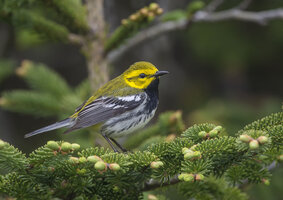
New pollen-replacing food for honey bees brings hope for survival
Scientists have unveiled a new food source designed to sustain honey bee colonies indefinitely without natural...

Foraging on the wing: How can ecologically similar birds live together?
A spat between birds at a backyard birdfeeder highlights the sometimes fierce competition for resources that...

Bumble bee decline tied to air pollution's disruption of gut microbiome
A study of bumble bees has uncovered a potential reason for the insects' decline. By studying...

Shrews shrink in winter to conserve energy, study finds
Newly published research from UNC Greensboro biology professor Dr. Bryan McLean and colleagues shows that the...
To avoid parasites, some fruit flies sacrifice sleep
If you think doomscrolling leads to sleepless nights, imagine waking up in bed with a blood-sucking...
Fishing for cephalopod DNA allows for efficient marine surveying
A new DNA probes allow for efficient surveying of the hidden lives of squids and octopuses...
Six decades of research bias: Fancy birds steal the spotlight, leaving drab species understudied
If you like watching, reading, or learning about pretty, colorful birds, you're not alone. But it...

'Internet of nature' helps researchers explore the web of life
A novel paper led by Dr. Ulrich Brose of the German Center for Integrative Biodiversity Research...

Global fisheries' nutrient extraction threatens ocean ecosystems and productivity, study finds
The four billion tons of marine organisms that global fisheries extracted from the ocean between 1960...

Hantavirus hotspots revealed: Six new rodent species identified as carriers
Hantavirus recently made news headlines as the cause of death for Betsy Arakawa, the wife of...

Venom characteristics of a deadly snake can be predicted from local climate
Local climate can be used to predict the venom characteristics of a deadly snake that is...

Pharmaceutical pollution alters migration behavior in salmon, study shows
In the largest study of its kind to date, a team of international researchers has investigated...

Bumblebee survival: Keeping killer moths at bay with strategic hive spacing
A study published in Frontiers in Bee Science has shown that physical distance plays a leading...

Two new tapeworm species discovered in wild oval squid
Researchers from the Physics and Biology Unit at the Okinawa Institute of Science and Technology (OIST)...

Who eats whom? New model for marine food webs calculates predator-prey relationships more precisely
Marine food webs are highly complex. Until now, researchers have been unable to understand exactly how...

In Croatia's freshwater lakes, 'selfish' bacteria hoard nutrients
Bacteria play key roles in degrading organic matter, both in the soil and in aquatic ecosystems....
Highly endangered sunflower star finds refuge in Canadian fjords
A team of oceanographers and marine biologists at the Hakai Institute, working with a colleague from...
Can we really resurrect extinct animals, or are we just creating hi-tech lookalikes?
From dire wolves to woolly mammoths, the idea of resurrecting extinct species has captured the public...
Caspian Sea's rapid decline threatens endangered seals, coastal communities and industry, study warns
Water levels in the Caspian Sea—the world's largest landlocked water body—are getting lower, as hotter temperatures...
Love songs in the sand: Researchers listen in to fiddler crab courtship
For the first time, a study led by University of Oxford researchers has listened in to...
Coral reefs exude myriad chemicals, fueling dynamic microbial recycling of nutrients
New research reveals the remarkable chemical diversity of substances exuded by coral reefs and demonstrates that...
Even a sublethal insecticide dose may disrupt the pollinator mating process
Insecticides can help protect crops against troublesome pests, but they also pose a risk for beneficial...
Parasites shrink starlings' range, impacting next generation's survival
Infections with parasites often entail no recognizable signs in many wildlife species, but can still have...
Light pollution stimulates cyanobacterial growth and metabolic processes in lakes, large-scale experiment shows
Everyone is familiar with the light dome that shows from afar where cities are brightly lit...
Predicting animal movements under global change
On our planet, at any one moment, billions of animals are on the move. From migratory...
Study finds evidence that prehistoric rhinos lived in huge herds
Rhinos that flourished across much of North America 12 million years ago gathered in huge herds,...
Farmers brought fish up the mountains of Europe as early as the 7th century, ancient DNA reveals
Ancient DNA extracted from a sediment core from a high-altitude Pyrenean lake in Spain reveals that...
International team calls for new approach to estimate crop yield potential and gaps
An international team of agronomists is calling for a new approach to estimate crop yield potential...
Coral restoration projects failing: One-third ineffective and unlikely to scale, study finds
As coral bleaching and deaths become more widespread globally, experts are re-evaluating the benefits of restoration...
Eclipse echoes: Study reveals surprising avian vocal patterns during solar eclipse
A study published in Scientific Reports reveals how birds responded to the April 8, 2024, total...

Bird species that do well in urban areas are more colorful and less brown, study finds
Researchers at the University of Granada and the Max Planck Institute for Biological Intelligence have demonstrated...

Zebrafish ovulation hormone discovery could impact fertility research
A team of international researchers has identified a new sex hormone that plays a crucial role...

Hantavirus in Madagascar linked to black rats in agricultural areas
Invasive species cause environmental mayhem when they establish themselves in a new ecosystem. But these interlopers...

How one species of bat uses its tail to navigate backwards in caves
A new study from Tel Aviv University reveals that the greater mouse-tailed bat (Rhinopoma microphyllum) uses...

Scientists blame climate change for spread of infectious diseases and unleashing of ice-locked microbes in Arctic
Climate change is creating new pathways for the spread of infectious diseases like brucellosis, tularemia, or...

Gila monsters may struggle to survive as planet grows warmer, study suggests
A team of ecologists, climatologists and evolutionary specialists affiliated with several institutions in the U.S. has...

New season of The Last of Us has a chance at realism—scientists discuss 'zombie fungus'
The Last of Us is back on April 13 and this season is more realistic than...
Scientists link a phytoplankton bloom to starving dolphins in Florida
In 2013, 8% of the bottlenose dolphins living in Florida's Indian River Lagoon died. Investigations have...

How do diverse plants get sick in the wild? Researchers head outdoors to answer a blue-sky question
The life of a plant scientist involves long hours in the lab, thinking up, designing, and...

Long-term studies at Jasper Ridge yield insights into oak ecosystems
Sitting atop the land of the Muwekma Ohlone Tribe, located on the eastern hills of the...

Picky eaters by day, buffet by night: Butterfly and moth diets sync to plant aromas
The scent of blooming flowers and fresh plant life is not just a perk of springtime;...

Prey size plays surprising role in competition among wolves, bears and cougars
New research from the University of Minnesota upends long-held understanding about how wolves, bears and cougars—three...

Animal behavioral diversity at risk in the face of declining biodiversity
Our environment is changing rapidly, largely as a result of human activities, leading to a significant...
Some insects are declining, but what's happening to the other 99%?
Insects are the dominant form of animal life on our planet, providing humans and wildlife with...
Timid tinkerers: Shy mice are more persistent problem-solvers, study finds
Why do some animals solve problems while others don't? The new study from the Max Planck...
Corpse flowers' survival at risk due to spotty recordkeeping
Commonly called the "corpse flower," Amorphophallus titanum is endangered for many reasons, including habitat destruction, climate...
Monkeys are world's best yodelers, 'voice breaks' analysis finds
A new study has found that the world's finest yodelers aren't from Austria or Switzerland, but...
Dark diversity reveals global impoverishment of natural vegetation
A study recently published in Nature indicates that human activities have a negative effect on the...
Genetic basis of camouflage in alpine Corydalis plants revealed
Camouflage is a common defensive strategy among animals. By modifying their coloration and patterning, animals evade...
Drought shrinks breeding range for California's wild salmon
An international team of researchers has found that climate change is negatively impacting the Californian wild...



